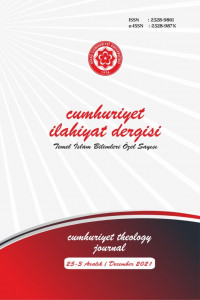İlmi Biyografi Kaynağı Olarak Murtażâ ez-Zebîdî’nin el-Mu‘cemü’l-Muḫtaṣ’ı
Al-Muʿjam Al-Muḫtaṣ Of Murtaḍā Al-Zabīdī As A Scientific Biographical Resource
Author(s): Ahmet EşerSubject(s): Metaphysics, Middle Ages, Islam studies, Philosophy of Religion, History of Islam, Sociology of Education
Published by: Cumhuriyet Üniversitesi İlahyat Fakültesi
Keywords: Ḥadīth; Murtadā Al-Zabīdī; Al-Muʿjam Al-Muḫtaṣ; Intellectuel Biography; Scientific Travels; Network;
Summary/Abstract: In this article which aims to reveal the scientific biography of Zabīdī, his ulema network and intellectual relations. Al-Mu'jam Al-muḫtaṣ of Murtadā Al-Zabīdī (d. 1205/1791) in which a scholar recorded his teachers, the books that he obtained the right to narrate during his education life and the chain of transmission from his teachers to the author, is one of the important representatives of the mu'jam genres in 12th/18th century. It can be said that the mu'jam that Zabīdī wrote to record the important people in his life, goes beyond the standard mu'jam with its compilation style, sources, diversity of biographers and anecdotes about the writing activity of the period. Based on Zabīdī's teachers, students and contemporaries, their origins, specialization and profession, the dates of their deaths, the dates of his encounters with them, the extent of his friendships, the dated rihle route, the lecture places and the books he taught, a panorama about the mu'jam will be drawn. The mu’jam, which includes 635 biographies, has a wide range of written and oral sources, especially ijazat and samā sources. Zabīdī's correspondence with scholars from different regions, taqrīz/appreciation written for his famous books and poems belonging to scholars of the period are among these sources. Numerous taqrīzs on his Tāj al-ʿArūs and Sharḥ Al-Iḥyā's point to their fame at that time, while Mu’jam, which has the appearance of an independent poetry anthology due to the poems that reach tens of pages, reveals his unknown poetic side. On the other hand, some couplets recorded in Persian and Turkish show his knowledge of these languages. Zabīdī is a versatile personality who lived in different geographies such as India, Yemen and Egypt and met many scholars there. Rihles in different regions of Yemen such as Zabid, Moravıa and Mocha, as well as inside Egypt, including Damietta, Raşıt, Fuwwah and Asyut, show that Zabīdī traveled frequently for the sake of knowledge. Egypt, where he went in 1167 (1753) with the advice of his teacher al-Aydarūs and spent thirty-eight years of his life, has an important place in his scientific adventure. Recording sufis, merchants and janitors as well as famous people from different fields such as poets, jurists and muhaddis in biographies reflects Zabīdī's extensive contact reaching various segments of society through the aforementioned rihles. While Zabīdī was obtaining knowledge through both these journeys and ijazat, he also gave ratification/ijazat to the students who came to him. While he prefers ijazat of almusalsal bil awwaliyyah and Al-Awail Ṣaḥīḥ/al-Kutub al-Sittah for those who come to him for short periods of time on the occasion of pilgrimage, but on the other hand he gaves ijazat of Ṣaḥīḥ al-Bukhari, Shamail Tirmidhi, Sharḥ Al-Iḥyā and Al-Amali for his long-term students. Lessons, both open to the public in mosques and with more private groups at home, were held in informal rather than systematic/formal style like in the madrasah. The books that Zabīdī received the right to transmit through his rihles are listed below under the "textbooks" heading. When a book is mentioned in whichever biography, it can be implicitly considered the person has the elevated chain of transmission of the book. Similarly, it can be revealed in which region and by whom tranmits the short chain of a book. This reveals the unknown aspects of regional and temporal writing style. On the other hand, it is possible to find other traces of the background of writing and representation/taqrir through the mu'jam. For instance, a book was sometimes typed as a result of the students' compilation of lecture notes of their masters, sometimes when a person obtained a book he needed and he abbreviated important parts and copied a special copy for himself or a student could only get permission for giving lectures after he had written a book. The mu’jam includes besides of Zabīdī's books, the books written by the biographers in the form of "he has many books" or by mentioning the name directly. Even the recording of details such as the reason for writing, date and content information reveals the unknown aspects of the book writing style of the period. Ultimately, the importance of mu’jam, which was written as the result of a life spent with learning, although it is not well known in terms of genre; is to mention the biographical information collected from many different secondary sources, compiled as a result of long effort, such as history and tabaqat-tarajim about the scientific life of the author together with their evidences. Therefore, these kinds of books, that are mostly written by the author himself or his close student, in which the teacher constitutes its main element, is a primary source in the determination of the biographical information of the author, as well as the book and isnad, deserve to be examined separately because of their potential to shed light on the unknown aspects of the hadith history and literature of the later period.
Journal: Cumhuriyet İlahiyat Dergisi
- Issue Year: 25/2021
- Issue No: 3
- Page Range: 1203-1229
- Page Count: 27
- Language: Turkish

